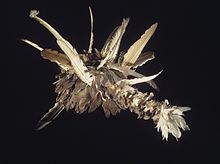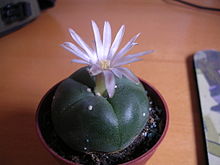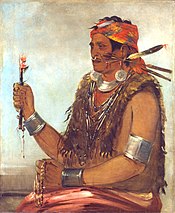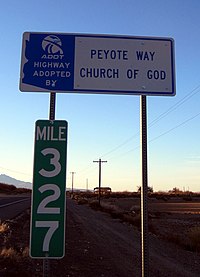Contents



| Part of a series on |
| Native Americans in the United States |
|---|
Native American religions are the spiritual practices of the Native Americans in the United States. Ceremonial ways can vary widely and are based on the differing histories and beliefs of individual nations, tribes and bands. Early European explorers describe individual Native American tribes and even small bands as each having their own religious practices. Theology may be monotheistic, polytheistic, henotheistic, animistic, shamanistic, pantheistic or any combination thereof, among others. Traditional beliefs are usually passed down in the forms of oral histories, stories, allegories, and principles.
Overview
Beginning in the 1600s, European Christians, both Catholics and those of various Protestant denominations, sought to convert Native American tribes from their pre-existing beliefs to Christianity. After the United States gained independence in the late 1700s, its government continued to suppress Indigenous practices and promote forcible conversion. Government agencies and religious organizations often cooperated in these forcible conversion efforts. In many cases, violence was used as a tool of suppression, as in the government's violent eradication of Ghost Dance practitioners in 1890.[1]
By the turn of the 20th century, the American government began to turn to less violent means of suppressing Native American religious beliefs. A series of federal laws was passed banning traditional Indigenous practices such as feasts, Sun Dance ceremonies and the use of the sweat lodge, among others.[2] This government persecution and prosecution officially continued until 1978 with the passage of the American Indian Religious Freedom Act (AIRFA), although it has been argued that the AIRFA had little real effect on the protection of Native religious beliefs.[3][4]
Another significant system of religious suppression was the removal of Native American children from their families into a system of government-funded and church-operated American Indian boarding schools (also known as residential schools). In these schools, Native children were forced through violence and oppression to learn European Christian beliefs, the values of mainstream white culture, and the English language, while simultaneously being forbidden to speak their own languages and practice their own cultural beliefs. This system of forcible conversion and suppression of Indigenous languages and cultures continued through the 1970s.[5][6][7]
Some non-Native anthropologists estimate membership in traditional Native American religions in the 21st century to be about 9000 people.[8][9] Since Native Americans practicing traditional ceremonies do not usually have public organizations or membership rolls, these "members" estimates are likely substantially lower than the actual numbers of people who participate in traditional ceremonies. Native American spiritual leaders also note that these academic estimates substantially underestimate the numbers of participants because a century of US Federal government persecution and prosecutions of traditional ceremonies caused believers to practice their religions in secrecy. Many adherents of traditional spiritual ways also attend Christian services, at least some of the time, which can also affect statistics. Since the 80 years of those prior legal persecutions ended with AIRFA, some sacred sites in the United States are now protected areas under law.[10]
Major Native American religions
Western America
Alaska Native religion
Traditional Alaskan Native religion involves mediation between people and spirits, souls, and other immortal beings.[11]
Earth Lodge Religion
The Earth Lodge Religion was founded in northern California and southern Oregon tribes such as the Wintun. It spread to tribes such as the Achomawi, Shasta, and Siletz, to name a few. It was also known as the "Warm House Dance" among the Pomo. It predicted occurrences similar to those predicted by the Ghost Dance, such as the return of ancestors or the world's end. The Earth Lodge Religion impacted the later religious practice, the Dream Dance, belonging to the Klamath and the Modoc.[12]
Longhouse Religion

The Longhouse Religion is the popular name of the religious movement known as The Code of Handsome Lake or Gaihwi:io ("Good Message"), founded in 1799 by the Seneca prophet Handsome Lake (Sganyodaiyoʔ).[13]
Waashat Religion
The Waashat Religion, also called the waasaní (Washani) Religion, Seven Drum Religion, the Longhouse religion (separate from the Iroquois Longhouse religion), and the Dreamer faith (or sometimes the Dreamer cult), is a faith still persisting in some modern Native communities. Washani, meaning "dancers" or "worship",[14] was a response to pressures from American settlers at the time for Natives to relocate or become "civilized". The Wanapum Indian Smohalla (c. 1815–1895) originally built the religion in the Columbia River region of modern-day Washington, and over time it has spread across the Pacific Northwest. Smohalla claimed that he had received visions in his dreams, where he had visited the spirit world and had been sent back to teach his people. [14] He preached a return to the original way of life of hunter-gatherer lifestyle as opposed to agriculturalism, before the influence of colonizers, emphasizing abstinence from alcohol and cleansing themselves of white influences. Smohalla was sometimes called Yuyunipitqana, meaning "Shouting Mountain", because it was said that his wisdom came from a mountain speaking within his soul. [15]
The religion combined elements of Christianity with Native beliefs, teaching similar origin stories as Catholicism and holding Sunday as a holy day, while still ultimately pushing away from the so-called civilized man that white people idealized.[15] Despite this, Smohalla rejected the Christian Puritanical ideal of a strong work ethic and plowing the land.[16] Two notable quotes of Smohalla's "You ask me to plough the ground! Shall I take a knife and tear my mother's bosom?"[15] and "My young men shall never work. Men who work can not dream, and wisdom comes to us in dreams," demonstrates these tenets. The Native-inspired elements of the religion involved the Waashat Dance, a dance which involves seven drummers, a salmon feast, use of eagle and swan feathers and a sacred song sung every seventh day. [13]
The Dreamer Faith foreshadowed the later Ghost Dances of the plains peoples, another religion which sought to rid Natives of white people and their influences through peaceful religion.[14] These kinds of religions made it difficult to assimilate or control the tribes by the United States, as the U.S. was trying to convert the Plains tribes from hunter-gatherers to farmers; farming was believed to be more civilized and a better use of the land.[16] They wanted to remake the Natives, but found a problem with those who followed the Waashat Religion: "Their model of a man is an Indian; They aspire to be Indian and nothing else." (T. B. Odeneal)[14] Smohalla was eventually jailed in an effort to quell a potential uprising of Native peoples, but his religion has continued to survive without him. [16]
Native Shaker Religion
Also known as Tschida, the Native Shaker Religion was influenced by the Waashat Religion and founded by John Slocum, a Squaxin Island member. The name comes from the shaking and twitching motions used by the participants to brush off their sins. The religion combines Christianity with traditional Indian teachings. This religion is still practiced today in the Indian Shaker Church. [13]
Arctic
Inuit religion
Traditional Inuit religious practices include animism and shamanism, in which spiritual healers mediate with spirits.[17]
Great Plains
Ghost Dance

The Ghost Dance movement of the late 1800s was a religious revitalization movement in the Western United States. Initially founded as a local ceremony in Nevada, by the Paiute prophet Wodziwob, the movement did not gain widespread popularity until 1889–1890, when the Ghost Dance Religion was founded by Wovoka (Jack Wilson), who was also Northern Paiute. The Ghost Dance was created in a time of genocide, to save the lives of the Native Americans by enabling them to survive the current and coming catastrophes, by calling the dead to fight on their behalf, and to help them drive the colonists out of their lands.[18]
In December 1888, Wovoka, who was thought to be the son of the medicine man Tavibo (Numu-tibo'o), fell sick with a fever during an eclipse of the sun, which occurred on January 1, 1889. Upon his recovery, he claimed that he had visited the spirit world and the Supreme Being and predicted that the world would soon end, then be restored to a pure state in the presence of the Messiah. All Native Americans would inherit this world, including those who were already dead, in order to live eternally without suffering. In order to reach this reality, Wovoka stated that all Native Americans should live honestly, and shun the ways of whites (especially the consumption of alcohol). He called for meditation, prayer, singing, and dancing as an alternative to mourning the dead, for they would soon resurrect. Wovoka's followers saw him as a form of the messiah and he became known as the "Red Man's Christ."
Tavibo had participated in the Ghost Dance of 1870 and had a similar vision of the Great Spirit of Earth removing all white men, and then of an earthquake removing all human beings. Tavibo's vision concluded that Native Americans would return to live in a restored environment and that only believers in his revelations would be resurrected.
This religion spread to many tribes on reservations in the West, including the Shoshone, Arapaho, Cheyenne, and Sioux (Dakota, Lakota, and Nakota). In fact, some bands of Lakota and Dakota were so desperate for hope during this period of forced relocation and genocide that, after making a pilgrimage to the Nevada Ghost Dance in 1889–1890, they became more militant in their resistance to the white colonists. Each Nation that adopted the Ghost Dance way provided their own understanding to the ceremony, which included the prediction that the white people would disappear, die, or be driven back across the sea. A Ghost Dance gathering at Wounded Knee in December 1890 was invaded by the Seventh Cavalry, who massacred unarmed Lakota and Dakota people, primarily women, children and the elderly.[19]
The earliest Ghost Dance heavily influenced religions such as the Earth Lodge, Bole-Maru Religion, and the Dream Dance. The Caddo Nation and several other communities still practice the Ghost Dance today, though usually in secret.[20]
North-Eastern America
Hudson Bay Interior/Subarctic
Omuskegowuk
Beliefs similar to Anishinaabeg Systems, different structure.[21]
Great Lakes Region
Ojibwa/Anishinaabeg
Mexico and Central America
Mexicayotl
Mexicayotl (Nahuatl word meaning "Essence of the Mexican", "Mexicanity"; Spanish: Mexicanidad; see -yotl) is a movement reviving the indigenous religion, philosophy and traditions of ancient Mexico (Aztec religion and Aztec philosophy) amongst the Mexican people.[22]
The movement came to light in the 1950s, led by Mexico City intellectuals, but has grown significantly on a grassroots level only in more recent times, also spreading to the Chicanos of North America.[23] Their rituals involve the mitotiliztli.[24] The followers, called Mexicatl (singular) and Mexicah (plural), or simply Mexica, are mostly urban and suburban people.[23]
The Mexicayotl movement started in the 1950s with the founding of the group Nueva Mexicanidad by Antonio Velasco Piña. In the same years, Rodolfo Nieva López founded the Movimiento Confederado Restaurador de la Cultura del Anáhuac,[25] the co-founder of which was Francisco Jimenez Sanchez who in later decades became a spiritual leader of the Mexicayotl movement, endowed with the honorific Tlacaelel. He had a deep influence in shaping the movement, founding the In Kaltonal ("House of the Sun", also called Native Mexican Church) in the 1970s.[26]
From the 1970s onwards Mexcayotl has grown developing in a web of local worship and community groups (called calpulli or kalpulli)[23] and spreading to the Mexican Americans or Chicanos in the United States. It has also developed strong ties with Mexican national identity movements and Chicano nationalism.[27] Sanchez's Native Mexican Church (which is a confederation of calpullis) was officially recognized by the government of Mexico in 2007.[28]
Pan-Native Traditions
Native American Church

The Peyote Religion (legally termed and more properly known as the Native American Church), also sometimes called the "Peyote Road" or the "Peyote Way", is a religious tradition involving the ceremonial and sacred use of Lophophora williamsii (peyote).[29] Use of peyote for religious purposes is thousands of years old and some have thought it to have originated within one of the following tribes: the Carrizo, the Coahuiltecan, the Lipan Apache, the Mescalero Apache, the Tonkawa, the Karankawa, or the Caddo, with the Plains Cree, Carrizo, and the Lipan Apache being the three most likely sources.[citation needed] In Mexico the Huichol, Tepehuán, and other Native Mexicans use peyote.[30]
Stomp Dance
Ceremonies
Green Corn Ceremony
The Green Corn Ceremony is an annual ceremony practiced among various Native American peoples associated with the beginning of the yearly corn harvest.[31]
Sun Dance
The sun dance is a religious ceremony practiced by a number of Native American and First Nations peoples, primarily those of the Plains Nations. Each tribe that has some type of sun dance ceremony that has their own distinct practices and ceremonial protocols. In many cases, the ceremony is held in private and is not open to the public. Most details of the ceremony are kept from public knowledge out of great respect for, and the desire for protection of, the traditional ways. Many of the ceremonies have features in common, such as specific dances and songs passed down through many generations, the use of traditional drums, the sacred pipe, praying, fasting and, in some cases, the piercing of the skin.
In Canada, the Plains Cree call this ceremony the Thirst Dance; the Saulteaux (Plains Ojibwe) call it the Rain Dance; and the Blackfoot (Siksika, Kainai, and Piikani) call it the Medicine Dance. It is also practiced by the Canadian Dakota and Nakoda, and the Dene.
Religious leaders
Leaders in Native religions include Popé, who led the Pueblo revolt in 1675, Quautlatas, who inspired the Tepehuan Revolt against the Spanish in 1616, Neolin, Tenskwatawa, Kenekuk, Smohalla, John Slocum, Wovoka, Black Elk and many others.

From time to time important religious leaders organized revivals. In Indiana in 1805, Tenskwatawa (called the Shawnee Prophet by Americans) led a religious revival following a smallpox epidemic and a series of witch-hunts. His beliefs were based on the earlier teachings of the Lenape prophets, Scattamek and Neolin, who predicted a coming apocalypse that would destroy the European-American settlers.[32] Tenskwatawa urged the tribes to reject the ways of the Americans: to give up firearms, liquor, American style clothing, to pay traders only half the value of their debts, and to refrain from ceding any more lands to the United States. The revival led to warfare led by his brother Tecumseh against the white settlers.[33] Juan de la Cruz Puc became seen as a prophet between the Yucatec Maya during the Caste War . Juan's sermons and prophecies were preserved in the A'almaj T'aan (Cruzo'ob Bible) and are still relevant between the Yucatec Maya people .
Congressional legislation

American Indian Religious Freedom Act
The American Indian Religious Freedom Act is a United States federal law and a joint resolution of Congress that provides protection for tribal culture and traditional religious rights such as access to sacred sites, freedom to worship through traditional ceremony, and use and possession of sacred objects for Native Americans, Inuit, Aleut, and Native Hawaiians. It was passed on August 11, 1978.
Native American Graves Protection and Repatriation Act
The Native American Graves Protection and Repatriation Act (NAGPRA), Pub.L. 101–601, 104 Stat. 3048, is a United States federal law passed on 16 November 1990 requiring federal agencies and institutions that receive federal funding to return Native American cultural items and human remains to their respective peoples. Cultural items include funerary objects, sacred objects, and objects of cultural patrimony.
Religious Freedom Restoration Act
The Religious Freedom Restoration Act of 1993 (also known as RFRA), is a 1993 United States federal law aimed at preventing laws that substantially burden a person's free exercise of religion. It was held unconstitutional as applied to the states in the City of Boerne v. Flores decision in 1997, which ruled that the RFRA is not a proper exercise of Congress's enforcement power. However, it continues to be applied to the federal government - for instance, in Gonzales v. O Centro Espirita Beneficente Uniao do Vegetal - because Congress has broad authority to carve out exemptions from federal laws and regulations that it itself has authorized. In response to City of Boerne v. Flores, some individual states passed State Religious Freedom Restoration Acts that apply to state governments and local municipalities.
Declaration on the Rights of Indigenous Peoples
The United Nations Declaration on the Rights of Indigenous Peoples was adopted by the United Nations General Assembly during its 61st session at UN Headquarters in New York City on 13 September 2007. Article 31, in particular, emphasizes that Indigenous Peoples have the right to their cultural heritage, including ceremonial knowledge, as protected intellectual property.
Sacred sites
The Native Sacred sites could be described as "specific, discrete, narrowly delineated location on Federal land that is identified by an Indian tribe, or Indian individual determined to be an appropriately authoritative representative of an Indian religion, as sacred by virtue of its established religious significance to, or ceremonial use by, an Indian religion".[34]
See also
Footnotes
- ^ Rhodes, John (January 1991) "An American Tradition: The Religious Persecution Of Native Americans." p.15. Montana Law Review Volume 52, Issue 1, Winter 1991
- ^ Rhodes 1991, p. 16, 33.
- ^ Public Law No. 95-341, 92 Stat. 469 (Aug. 11, 1978)
- ^ Rhodes 1991, p. 69.
- ^ Hall, Anna (12-16-2013) "Time for Acknowledgement: Christian-Run Native American Boarding Schools Left Legacy of Destruction" in Sojourners
- ^ Smith, Andrea (March 26, 2007) "Soul Wound: The Legacy of Native American Schools Archived 2012-12-06 at the Wayback Machine" in Amnesty International Magazine
- ^ Boxer, Andrew (2009) "Native Americans and Federal Government" in History Review
- ^ James T. Richardson (2004). Regulating Religion: Case Studies from Around the Globe. Springer. p. 543. ISBN 9780306478864.
- ^ "NJJN" (PDF). Retrieved May 21, 2014.
- ^ United States (2013). Indian sacred sites: balancing protection issues with federal management. America in the 21st century: political and economic issues. Christopher N. Griffiths (ed.). New York: Nova Science Publishers, Inc. ISBN 978-1628082845.
- ^ Merkur 1985: 4
- ^ Waldman 230
- ^ a b c Waldman, Carl. (2009). Atlas of the North American Indian. Checkmark Books. New York. ISBN 978-0-8160-6859-3.
- ^ a b c d Andrew H. Fisher. "American Indian Heritage Month: Commemoration vs. Exploitation". Archived from the original on February 25, 2015. Retrieved January 4, 2012.
{{cite web}}: CS1 maint: unfit URL (link) - ^ a b c "Smohalla (1815?-1895)". www.historylink.org. Retrieved October 16, 2023.
- ^ a b c Calloway, Colin Gordon (2019). First peoples: a documentary survey of American Indian history (Sixth ed.). Boston: Bedford/St. Martin's, Macmillan Learning. ISBN 978-1-319-10491-7.
- ^ Texts of mythology Sacred text.com. Retrieved 26 January 2013.
- ^ Mooney, James. The Ghost Dance Religion and Wounded Knee. New York: Dover Publications; 1896
- ^ Waldman 230–231
- ^ Cross, Phil. "Caddo Songs and Dances" Archived 2010-08-24 at the Wayback Machine. Caddo Legacy from Caddo People. Retrieved 27 Nov 2012.
- ^ Bird, Louis (2011). Telling Our Stories: Omushkego Legends & Histories from Hudson Bay. Toronto: University of Toronto Press. pp. 119–131. ISBN 978-1-55111-580-1.
- ^ Yolotl González Torres. The Revival of Mexican Religions: The Impact of Nativism. Numen - International Review for the History of Religions. Vol. 43, No. 1 (Jan., 1996; published by: BRILL), pp. 1-31
- ^ a b c Susanna E. Rostas. Mexicanidad: The Resurgence of the Indian in Popular Mexican Nationalism. University of Cambridge, 1997.
- ^ Jennie Marie Luna. Danza Azteca: Indigenous Identity, Spirituality, Activism and Performance. San Jose State University, Department of Mexican American Studies. 2011
- ^ Lauro Eduardo Ayala Serrano. Tiempo Indígena: la construcción de imaginarios prehispánicos.
- ^ Tlacaelel Francisco Jimenez Sanchez biography. In Kaltonal, 2005.
- ^ Zotero Citlalcoatl. AMOXTLI YAOXOCHIMEH.
- ^ Religión prehispánica renace en el Siglo 21. Vanguardia, 2008.
- ^ Waldman 231
- ^ Stewart, Omer C. Peyote Religion: A History. University of Oklahoma Press: Norman and London, 1987. P. 47
- ^ Roy, Christian (2005). Traditional festivals: a multicultural encyclopedia. Santa Barbara, CA: ABC-CLIO. pp. 35–37. ISBN 9781576070895.
- ^ Adam Jortner, The Gods of Prophetstown: The Battle of Tippecanoe and the Holy War for the American Frontier (2011)
- ^ Rachel Buff, "Tecumseh and Tenskwatawa: Myth, Historiography and Popular Memory." Historical Reflections/Réflexions Historiques (1995): 277-299.
- ^ Clinton, Bill (1996). "Executive Order 13007--Indian sacred sites". Weekly Compilation of Presidential Documents. 32 (21): 942.
Bibliography
- Brown, Brian Edward (1999). Religion, Law, and the Land: Native Americans and the Judicial Interpretations of Sacred Land. Westport, Conn: Greenwood Press. ISBN 978-0-313-30972-4
- Buff, Rachel. "Tecumseh and Tenskwatawa: Myth, Historiography and Popular Memory." Historical Reflections/Réflexions Historiques (1995): 277–299.
- Carpenter, Kristen A., A Property Rights Approach to Sacred Sites: Asserting a Place for Indians as Nonowners, 52 UCLA Law Review 1061 (2005).
- Carpenter, Kristen A., Individual Religious Freedoms in American Indian Tribal Constitutional Law, "The Indian Civil Rights Act at Forty." UCLA American Indian Studies Publications, 2012, ISBN 978-0-935626-67-4.
- Garrett, Michael; Garrett, J. T. (2003). Native American Faith in America. Faith in America. J. Gordon Melton, series editor. New York: Facts On File. ISBN 0-8160-4989-0.
- Getches, David H., Wilkinson, Charles F., Williams, Robert A. Jr. "Cases and Materials on Federal Indian Law- Fifth Edition." Thomas West Company: the United States, 1998. ISBN 978-0-314-14422-5.
- Griffiths, Christopher N., ed. (2013). Indian sacred sites: balancing protection issues with federal management. America in the 21st century: political and economic issues. New York: Nova Science Publishers. ISBN 978-1628082845.
- Leavelle, Tracy Neal (2010). "American Indians". In Goff, Philip (ed.). The Blackwell Companion to Religion in America. Malden, Ma; Oxford: Wiley-Blackwell. pp. 397–416. ISBN 978-1-4051-6936-3.
- Melton, J. Gordon; et al., eds. (2009) [1978]. "Native American Religions". Melton's Encyclopedia of American Religions (8th ed.). Detroit, Mi: Gale Cengage Learning. ISBN 978-0-787-69696-2. (archived)
- Mooney, James (1896). The Ghost Dance Religion and Wounded Knee. New York: Dover Publications.
- Rhodes, John (January 1991). "An American Tradition: The Religious Persecution Of Native Americans". Montana Law Review. 52 (1 (Winter 1991)).
- Stewart, Omer C. (1987). Peyote Religion: A History. Norman, Ok; London: University of Oklahoma Press. ISBN 978-0-8061-2068-3.
- Utter, Jack (2001). American Indians: Answers to Today's Questions. 2nd ed. Norman, Ok; London: University of Oklahoma Press. ISBN 978-0-8061-3313-3.
- Waldman, Carl. (2009). Atlas of the North American Indian. Checkmark Books. New York. ISBN 978-0-8160-6859-3.


